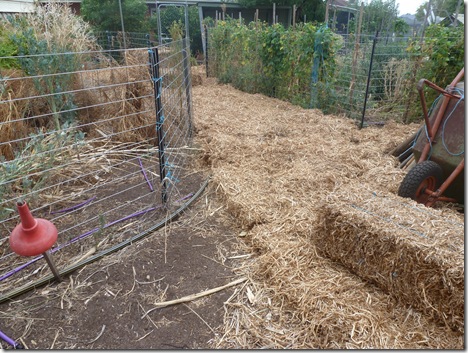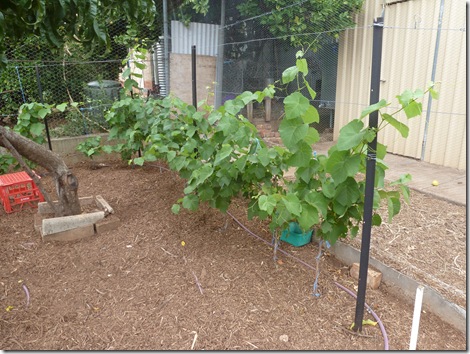The highest cost in growing one’s own fruit and vegetables in Adelaide (South Australia) is the cost of water, where the new water prices for the 2011-12 financial year were:
1) Quarterly water supply charge of $58.65
2) $1.93/kL for water use from 0-30 kL per quarter
3) $2.75/kL for water use from 30-130 kL per quarter
4) $2.98/kL for water use above 130kL
During the summer months (December through to the end of February) I’ve used 166kl (166 000 litres) of water from the mains supply. Almost all of this water went onto the garden, with household use being negligible after all the practice we’ve had conserving water during the recent decade of droughts.
Nor does this figure include the 60 kl of rainwater carried over from last winter in our giant tanks and now almost gone. All this, despite cutting back on the size of the garden planted out this year as a consequence of the gardener’s absence during the critical spring planting season…
So the cost of water for this past summer has been: -
$58.65 + 30kl x $1.93 + 100 kl x $2.75 + 33kl x $2.98 = $490.
Not far behind the cost of water is the cost of mulch to protect the soil, prevent evaporative losses and to keep the soil cool and the worms near the surface. We use pea-straw for this, purchased in bulk at about $6.60 per bale, and needing about one bale per square meter to apply.
The cost of buying water and mulch heavily outweigh the cost of seed and seedlings, new tools and various stakes and fencing materials in the gardener's budget. I’ve never had the courage to do a more careful analysis, but I reckon the cost of operating this 1000 square meter garden runs to some thousands of dollars each year, putting real pressure on the gardener to produce edible food sufficient to offset the costs of shopping at a greengrocer.
 So each year I try some new method of making water and mulch go a bit farther.
So each year I try some new method of making water and mulch go a bit farther.
This year I’m laying down about $500 worth of pea-straw (about 75 bales) along the dirt paths surrounding the fenced growing beds. This layer of mulch will allow winter rainfall to percolate through for safe storage well into next Spring, give the chickens somewhere to scratch for earwigs, and provide a mulch in a more broken-down form for surrounding small plants come next Summer’s heat waves. (Mulch for seedlings is collected off the paths, as it is softer than new straw and less full of moulds and other stuff from the farm where it grew). Each bale is broken up into ‘bricks’ about 10cm wide; these are as easy to lay down as carpet squares, and are just dropped on the soil and kicked into place.
Over the next five years, these constant applications of mulch will build up the carbon content of the soils and make them more friable for tiny roots to grow through. In the orchard (below) those new grapevines are doing well in last year’s mulch, now broken down by the constant contented scratching of the five hens who hang out here.
In the long-term though, I’d like to reach a place where I can grow my own ‘green cover’ during winter, cut it in Spring, use it for mulch over Summer, and grow all crops on the 75 000 litres of water captured from winter rainfall on surrounding roofs and plumbed into those tanks.








